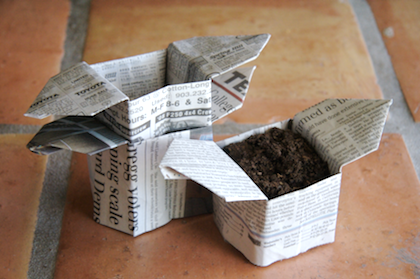Peat extraction is highly damaging to ecosystems as peat grows slowly enough, 1 mm. per year according to Royal Horticultural Society, to be considered a non-renewable resource. While many gardeners have traditionally started and grown-on seeds indoors in peat pots and in peat-based growing mixes, there are a number of environmentally friendly alternatives that can be purchased or made at home.
Environmentally friendly, Biodegradable Pots
Seedlings can be grown in newspaper pots which can easily be made by rolling a strip of newspaper around a bottle or container and tucking the edges under the bottom for a base. If made from a single layer of newspaper these can be put directly into the garden or vegetable bed where they will break down naturally allowing roots to reach deep into the soil for nutrients. If made with a few layers of newspaper, the pots are sturdier but the newspaper may not break down quickly enough to let roots reach into the soil, so the seedlings will need to be gently removed from thicker pots before planting. I like to make the pots square or rectangular so they can be packed against each other for support and space-efficiency as they grow to transplantable size. Google: 'Newspaper Pots' for ‘how-to’ information.
There are a number of biodegradable ‘fiber pots’ on the market which are made of various recycled, sustainable or organic materials including recycled paper, wood wastes, cereal and grain hulls. Pressed fiber pots are designed to be put directly into the garden with the young seedlings in them where they break down over time. Though these pots are labeled biodegradable, some brands do not break down quickly, the sides and bottoms may need to be removed before planting; make sure to ask for feedback at the garden centre or nursery when purchasing biodegradable pots.
Options to Plastic Seed-starting Pots, and Peat-based Starting Mixes
There are other eco-pots on the market which are designed to replace the plastic starter packs. These are not designed to break down so seedlings are removed from these pots before planting. Plastic-alternative pots are made of pressed natural materials that are often coated with vegetable-based glazes to give them durability. Some are reported to last five years. Pressed materials are also being used to make large pots. Reading labels on all these new products may be interesting and fun.
For decades, peat-based starting mixes have been used to fill pots for starting seeds. Gardeners are now looking for environmentally-friendly alternatives and new products are entering the market each year. Some are locally produced; others are by waste by-products such as coconut coir. Last year I received compressed coir blocks as a gift so started vegetable seeds in coir, green-waste and fishery-waste composts. Unlike some of the alternatives introduced 4-5 years ago that were too ‘barky’, all were finely textured products which produced excellent germination and growth. I needed to adjust my watering schedule since each growing medium held moisture differently than peat, but this was easy. The Royal Horticultural Society has conducted growing trials with peat-free alternatives. Their results and recommendations are available at their website.
Author: Jane Sherrott, MG, Vancouver Chapter





